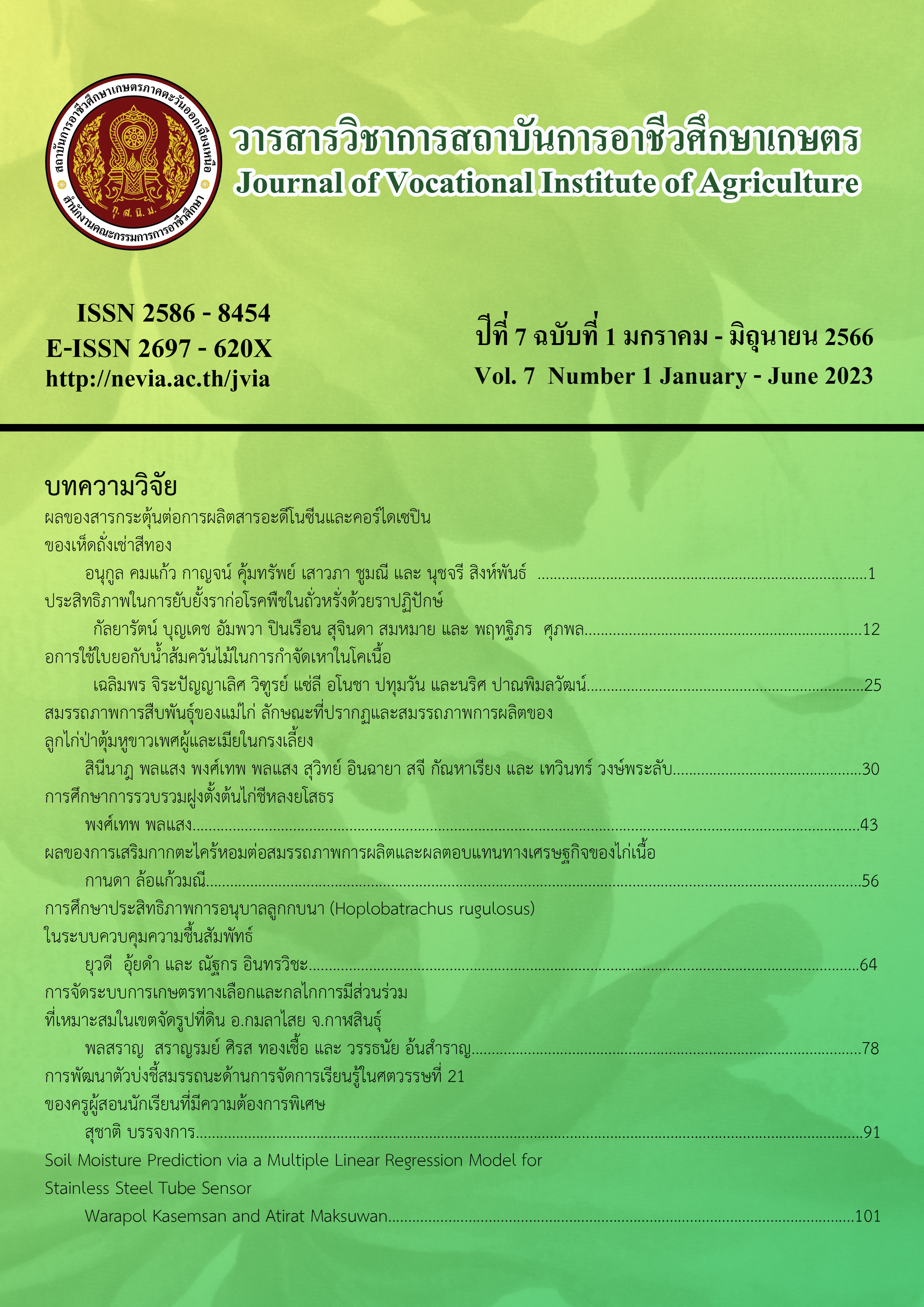Efficiency of the relative humidity control system for tadpole (Hoplobatrachus rugulosus) nursing
Main Article Content
Abstract
The objective of this study was to study the efficiency of relative humidity control system for the nursing of tadpole (Hoplobatrachus rugulosus). The research methods were divided into 2 steps;
1) designing the relative humidity control for the tadpole nursing and 2) comparing the efficiency tadpole nursing system between relative humidity control and traditional system. Natural environmental structures including air temperature, light intensity, water temperature and relative humidity and tadpole’s growth indicators including weight, length and survival rate were collected. The result showed that relative humidity in control system was 88.72 throughtout 30 days of experimental time. Weight and length of tadpole in the relative humidity control system was higher than the traditional system significant difference (p<0.05) at 52.73±6.54, 27.72±2.09 grams and 8.76±0.39, 8.05±0.34 centimeter respectively. The survival rate of tadpole in the relative humidity control and traditional system were 70.3 and 62%, respectively.
Article Details

This work is licensed under a Creative Commons Attribution-NonCommercial-NoDerivatives 4.0 International License.
The content and information in articles published in the Journal of Vocational Education in Agriculture are the opinions and responsibility of the article's author. The journal editors do not need to agree or share any responsibility.
Articles, information, content, etc. that are published in the Journal of Vocational Education in Agriculture are copyrighted by the Journal of Vocational Education in Agriculture. If any person or organization wishes to publish all or any part of it or to do anything. Only prior written permission from the Journal of Vocational Education in Agriculture is required.
References
Department of Fisheries. (2020). Statistics of freshwater aquaculture production 2020. Available from https://www4.fisheries.go.th/local/index.php/main/viewactivities/1408/85332. Accessed date: 18 September 2020. (in Thai)
Talaad Thai. (2020). Big frog price. Available from https://talaadthai.com/product/11-1-01-frog-largesize? date=2020-08-05. Accessed date: 30 September 2020. (in Thai)
Uydam, Y., et al. (2021). Knowledge capturing of raising frogs. Pathum Thani: Rangsit University Press. (in Thai)
Uppanunchai, A. & Singsom, P. (2004). Nursing of common lowland frog, Rana rugulosa (Wiegmann) tadpole at different stocking densities. (Research reports). Bangkok: Inland Fisheries Research and Development Bureau, Department of Fisheries. (in Thai)
Pipoppinyo, S. & Whangchai, N. (1997). Bullfrog rearing (Bullfrog, Rana catesbeiana) by using ready meals. Fishries Gazette, 50(1), 79-85. (in Thai)
Chantacot, R. (2008). A Study on the Growth and Survival Rate of Frog (Rana tigerrina) by Different Kinds of Food, (Master thesis, Srinakharinwirot University). (in Thai)
Thongklongsai, T., et al. (2011). The Developmental Hybrid Frog Raising Model in Cement Ponds, Cage and Earth Ponds. In The National and International Conference of Khon Kaen University 2011 (p. 38-43). 27-29 January, 2011, Khon Kaen, Thailand. (in Thai)
Treepolaugson, S. & Intaravicha, N. (2021). Effect of Light Intensity on Nursing of Frog Tadpoles (Hoplobatrachus rugulosus). Journal of Vocational Institute of Agriculture, 5(1), 1-8. (in Thai)
Liamtong, S., et al. (2019). Effect of water temperature on growth, survival and health status of East Asian Bullfrog (Hoplobatrachus rugulosus) Larvae. In International Conference on Biodiversity 2019 (p. 55-61). 22-24 May, 2019, Bangkok, Thailand.
Mitchell, A. & Bergmann, P. J. (2016). Thermal and moisture habitat preferences do not maximize jumping performance in frogs. Functional Ecology, 30, 733–742.
Bellis, E. D. (1962). The Influence of Humidity on Wood Frog Activity. The American Midland Naturalist, 68(1), 139-148.
Blaustein, A. R., et al. (2010). Direct and Indirect Effects of Climate Change on Amphibian Populations. Diversity, 2(2), 281-313.
Mills, N. E. & Barnhart, M. C., et al.(1999). Effects of Hypoxia on Embryonic Development in Two Ambystoma and Two Rana Species. Physiological and Biochemical Zoology, 72(2), 179-88.
Sawangpanich, P. (1979). The effect of temperature on the development of frog eggs. (Rana tigerina Daudin), (Master thesis, Kasetsart University). (in Thai)

